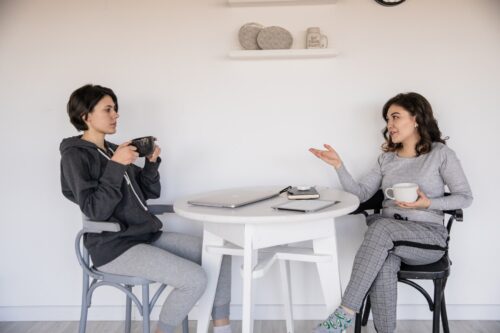Body language is a powerful form of nonverbal communication that can greatly impact our relationships and success in various aspects of our professional life. It involves the use of facial expressions, gestures, postures, and other physical cues to convey emotions, thoughts, and intentions. Understanding and effectively interpreting body language can help us navigate social interactions, build stronger connections, and achieve our goals.
Understanding the Importance of Body Language in Communication
While verbal communication is important, research shows that a significant portion of our communication is actually conveyed through nonverbal cues. In fact, studies suggest that up to 93% of our communication is nonverbal. This highlights the crucial role that body language plays in conveying meaning and understanding.
Body language provides insight into a person’s true feelings and intentions, often revealing more than their words alone. For example, crossed arms may indicate defensiveness or resistance, while eye contact and a relaxed posture can signal openness and engagement. By paying attention to these cues, we can gain a deeper understanding of others and adjust our own behavior accordingly.
Common Body Language Cues and Their Meanings
To effectively decode body language, it is important to familiarize ourselves with common cues and their corresponding meanings. While it is essential to consider context and individual differences, here are some general interpretations of common body language cues:
- Facial Expressions: Smiling indicates happiness or friendliness, while frowning suggests displeasure or sadness. Raised eyebrows can indicate surprise or interest.
- Gestures: Nodding can signal agreement or understanding, while shaking the head may convey disagreement or disbelief. Pointing can indicate emphasis or direction.
- Posture: Leaning forward can signal interest, while leaning back may indicate detachment or disinterest. Slouched shoulders can convey low confidence or fatigue.
- Eye Contact: Sustained eye contact is often associated with attentiveness and sincerity, while avoiding eye contact may suggest shyness or dishonesty.
Remember, these interpretations are not definitive, and cultural and individual differences should always be taken into account when interpreting body language cues.
How Body Language Affects Relationships
Body language plays a crucial role in the development and maintenance of relationships. It can either enhance or hinder communication, trust, and rapport.
Positive body language, such as maintaining eye contact, nodding, and open postures, can foster a sense of connection and engagement. It shows that we are actively listening and interested in what the other person is saying. This can lead to stronger relationships, improved understanding, and increased cooperation.
On the other hand, negative body language, such as crossed arms, avoiding eye contact, or fidgeting, can create barriers and send signals of disinterest or defensiveness. This can lead to misunderstandings, conflict, and strained relationships.
By becoming aware of our own body language and actively observing the cues of others, we can navigate interpersonal interactions with greater sensitivity and effectiveness, ultimately strengthening our relationships.
Improving Listening Skills for Better Understanding
Effective listening is a vital component of communication and can greatly enhance our ability to understand others and respond appropriately. While verbal listening skills are important, nonverbal listening skills are equally crucial.
Nonverbal listening skills involve paying attention to the speaker’s body language and other nonverbal cues. This includes observing their facial expressions, gestures, and overall posture. By doing so, we can gain valuable insights into the speaker’s emotions, attitudes, and intentions, allowing for a more accurate understanding of their message.
To improve nonverbal listening skills, it is essential to practice active observation and be fully present in the moment. This means avoiding distractions, maintaining eye contact, and being open to receiving nonverbal cues. By honing these skills, we can become more attuned to others and develop stronger connections based on genuine understanding.
Techniques for Effective Nonverbal Communication
In addition to understanding and interpreting body language, developing our own nonverbal communication skills is equally important. Here are some techniques to enhance our nonverbal communication abilities:
- Posture and Body Alignment: Maintaining an open and upright posture conveys confidence and approachability. Avoid slouching or crossing your arms, as this can create a barrier between you and others.
- Eye Contact: Establishing and maintaining appropriate eye contact helps establish trust and demonstrates attentiveness. However, it is important to strike a balance and avoid staring excessively, which may make others uncomfortable.
- Gestures: Using appropriate hand gestures can enhance communication and emphasize key points. However, excessive or distracting gestures should be avoided, as they can detract from the message.
- Facial Expressions: Being aware of our facial expressions can help ensure that our emotions align with our words. Smiling when appropriate and displaying genuine interest can make conversations more engaging and positive.
Remember, nonverbal communication should complement and align with our verbal communication. It is important to strive for consistency between what we say and how we say it to avoid confusion or mixed messages.
The Role of Body Language in Professional Settings
Body language plays a significant role in professional settings, where impressions and relationships can impact career growth and success. Employers and colleagues often pay attention to nonverbal cues to assess confidence, credibility, and leadership potential.
Confident body language, such as maintaining good posture, making eye contact, and using assertive gestures, can convey competence and command respect. It can also influence how others perceive our level of expertise and authority.
In contrast, weak or insecure body language, such as avoiding eye contact, fidgeting, or slouching, can undermine our professional image and hinder career advancement. It is important to be mindful of our body language and project confidence and professionalism to make a positive impression in the workplace.
Using Body Language to Enhance Personal and Professional Success
By harnessing the power of body language, we can enhance both our personal and professional success. Here are some strategies to leverage body language for positive outcomes:
- Confidence and Presence: Project confidence through open and assertive body language. Stand tall, maintain eye contact, and use purposeful gestures to convey self-assurance.
- Active Listening: Demonstrate active listening by nodding, maintaining eye contact, and using facial expressions to show engagement and understanding. This fosters better communication and strengthens relationships.
- Empathy and Understanding: Use body language to express empathy and understanding. Adopt an open and supportive posture, use appropriate facial expressions, and provide appropriate physical touch, such as a pat on the back, when appropriate.
- Adaptability: Be aware of cultural differences in body language and adapt accordingly. What may be considered respectful in one culture may be perceived as offensive in another. Respect and adapt to the cultural norms of others to avoid misunderstandings and foster positive connections.
Body Language Exercises and Tips for Practice
To improve our body language skills, it is important to practice and develop self-awareness. Here are some exercises and tips to enhance your body language:
- Mirror Exercise: Stand in front of a mirror and observe your own body language. Practice different postures, gestures, and facial expressions to see how they influence your appearance and mood.
- Role-Play: Engage in role-play scenarios where you can practice different body language cues and observe their impact on others. This can be done with a partner or in a group setting.
- Video Recording: Record yourself in various social and professional interactions and analyze your body language afterward. Look for areas of improvement and make adjustments accordingly.
- Seek Feedback: Ask trusted friends, colleagues, or mentors to provide honest feedback on your body language. They can offer valuable insights and suggestions for improvement.
By actively practicing these exercises and incorporating body language awareness into our daily lives, we can enhance our nonverbal communication skills and reap the benefits of improved relationships and success.
Conclusion: Harnessing the Power of Body Language for Improved Relationships and Success
In conclusion, body language is a powerful tool that can significantly impact our relationships and success. By understanding and effectively decoding body language cues, we can gain deeper insights into others, improve our listening skills, and enhance our nonverbal communication abilities.
Whether in personal or professional settings, body language plays a crucial role in conveying meaning, establishing connections, and building trust. By being mindful of our own body language and actively observing the cues of others, we can navigate social interactions with greater sensitivity and effectiveness.
Through practice and self-awareness, we can harness the power of body language to strengthen relationships, foster understanding, and achieve personal and professional success. So, start paying attention to the unspoken messages conveyed through body language, and watch as your relationships and opportunities flourish.
Take the first step towards improving your body language skills today. Practice active observation, seek feedback, and be mindful of your nonverbal cues in your daily interactions. With dedication and awareness, you can unlock the potential of body language to enhance your relationships and achieve success. Contact WHS and Training Compliance Solutions for your next elearning or onsite training session.












